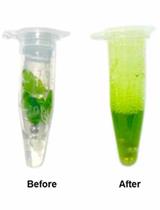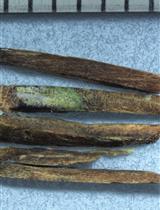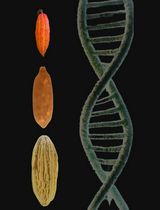- EN - English
- CN - 中文
Quantification of Botrytis cinerea Growth in Arabidopsis thaliana
拟南芥灰葡萄孢生长的定量研究
发布: 2023年08月20日第13卷第16期 DOI: 10.21769/BioProtoc.4740 浏览次数: 2409
评审: Shweta PanchalAntony ChettoorAnonymous reviewer(s)
Abstract
Yield losses attributed to plant pathogens pose a serious threat to plant productivity and food security. Botrytis cinerea is one of the most devastating plant pathogens, infecting a wide array of plant species; it has also been established as a model organism to study plant–pathogen interactions. In this context, development of different assays to follow the relative success of B. cinerea infections is required. Here, we describe two methods to quantify B. cinerea development in Arabidopsis thaliana genotypes through measurements of lesion development and quantification of fungal genomic DNA in infected tissues. This provides two independent techniques that are useful in assessing the susceptibility or tolerance of different Arabidopsis genotypes to B. cinerea.
Key features
• Protocol for the propagation of the necrotrophic plant pathogen fungus Botrytis cinerea and spore production.
• Two methods of Arabidopsis thaliana infection with the pathogen using droplet and spray inoculation.
• Two readouts, either by measuring lesion size or by the quantification of fungal DNA using quantitative PCR.
• The two methods are applicable across plant species susceptible the B. cinerea.
Graphical overview

A simplified overview of the droplet and spray infection methods used for the determination of B. cinerea growth in different Arabidopsis genotypes
Background
Agricultural productivity is constantly under threat from plant pathogens including bacteria, fungi, oomycetes, and viruses, contributing to global losses of 10%–28% in crop production to pests (Savary et al., 2019; IPPC Secretariat, 2021). Among the pathogens, Botrytis cinerea is a necrotrophic fungal phytopathogen distributed worldwide that causes great damage to a large diversity of plants, including various crops, leading to its classification among the top 10 worst fungal pathogens (Dean et al., 2012; Caseys et al., 2021). B. cinerea is considered a generalist necrotroph that kills the host tissues and takes up nutrients from the dead tissue. Unlike other plant pathogens, it has a very broad host range, affecting more than 1,000 plant species (Elad et al., 2016; Caseys et al., 2021; Bi et al., 2022).
The strong economic impact with regard to yield loss and the broad range of plant hosts make B. cinerea an interesting model organism for plant pathogen research, especially as it also infects the model plant species Arabidopsis thaliana. This allowed, for example, extensive transcriptomic analysis of the necrotroph infection (Windram et al., 2012) or studies on how the genetic variation of Arabidopsis or B. cinerea influences disease outcomes (Kliebenstein et al., 2005; Rowe and Kliebenstein, 2008; Soltis et al., 2020). Furthermore, B. cinerea infection assays can be used to observe different aspects of the plant immune responses in Arabidopsis (Genenncher et al., 2016; Guzha et al., 2022). Here, we show two straightforward methods that can be used in parallel to assess the disease tolerance of different Arabidopsis genotypes. One method involves drop inoculation of B. cinerea spores and measuring the average lesion development on the infected leaves (Genenncher et al., 2016; Guzha et al., 2022). The other approach involves the quantification of B. cinerea genomic DNA (gDNA) in infected Arabidopsis tissues (Ettenauer et al., 2014; Guzha et al., 2022). These two methods provided are versatile and can be applied to different plant species susceptible to the pathogen with minimal modifications.
Materials and reagents
Biological materials
Arabidopsis seeds
B. cinerea strain B05-10
Reagents
Vogel buffer
Potato dextrose agar (PDA) (Merck, catalog number: 70139)
Potato dextrose broth (PDB) (Merck, catalog number: P6685)
Glycerol (Thermo Scientific, catalog number: 17904)
Plant/Fungi DNA Isolation kit (Norgen Biotek Corporation, catalog number: 26200)
Takyon No Rox SYBR master mix dTTP Blue (Eurogentec UF-NSMT-B0701)
B. cinerea ACTIN forward primer 5′-TGGAGATGAAGCGCAATCCA-3′ (GenewizTM)
B. cinerea ACTIN reverse primer 5′-AAGCGTAAAGGGAGAGGACG-3′ (GenewizTM)
B. cinerea TUBULIN forward primer 5′-CCGTCATGTCCGGTGTTAC-3′ (GenewizTM)
B. cinerea TUBULIN reverse primer 5′-CGACCGTTACGGAAATCGG-3′ (GenewizTM)
Solutions
Potato dextrose agar (PDA) and potato dextrose broth (PDB) (see Recipes)
Sterile Vogel buffer (see Recipes)
70% ethanol (see Recipes)
15% glycerol (see Recipes)
Recipes
Potato dextrose agar (PDA) and potato dextrose broth (PDB)
Potato dextrose agar (PDA)
For 1 L of PDA, weigh 39 g of commercial PDA powder (contains 20 g of dextrose, 15 g of agar, and 4 g of potato extract), and suspend in 1 L of deionised water. Autoclave the solution at 121 °C for 20 min.
Potato dextrose broth (PDB)
For 1 L of PDB, weigh 24 g of commercial PDB powder (contains 20 g of dextrose, 4 g of potato extract) and dissolve in 1 L of deionised water. Autoclave at 121 °C for 20 min.
Sterile Vogel buffer
For 1 L of Vogel buffer, weigh the compounds as shown in Table 1 and fill up to 900 mL with distilled water. Mix until all compounds are dissolved.
Table 1. Preparation of Vogel buffer
Constituent Amount Sucrose 15 g Trisodium citrate·2H2O 2.5 g K2HPO4 5 g MgSO4·7H2O 0.2 g CaCl2·2H2O 0.1 g NH4NO3 2 g Adjust to pH 6.0 and fill up the volume to 1 L. Sterilise the buffer by autoclaving.
70% ethanol
Reagent Final concentration Amount Ethanol (absolute) 70% 700 mL H2O n/a 300 mL Total n/a 1,000 mL 15% glycerol
Reagent Final concentration Amount Glycerol 15% 150 mL H2O n/a 850 mL Total n/a 1,000 mL Sterilize by autoclaving.
Laboratory supplies
10 cm plant pots
25 cm × 51 cm × 6 cm propagation trays
25 cm × 51 cm × 18 cm high standard dome
Arabidopsis soil: Fruhstofer Erde
Chemical-resistant gloves
Miracloth (Merck, catalog number: 475855)
Kimwipes® (Kimtech Science, catalog number: 34120)
2 mL microcentrifuge tube (Sarstedt, catalog number: 72.695.500)
1.5 mL microcentrifuge tube (Sarstedt, catalog number: 72.690.001)
Flat cap PCR tubes (Sarstedt 72.985.002 (tubes) and 65.989.002 (lids))
60 mL glass spray bottle (Uline, catalog number: S24562A)
Equipment
Growth chamber with light and temperature controls (Percival Scientific Inc.)
Oven for sterilisation of soil
Microcentrifuge
Micropipettes
Scalpel
Mortar and pestle
MarCal 16ER digital caliper (Mahr, Göttingen, Germany)
Bio-Rad iQ5 Multicolor Real-Time PCR Detection System
NanoDrop 2000 spectrophotometer (Thermo Fisher Scientific)
Fuchs-Rosenthal counting chamber (Paul Marienfeld, Lauda-Königshofen, Germany)
Software and datasets
MarCom Standard Software for MarCal digital caliper
iQ5 Optical System Software (Bio-Rad Laboratories GmbH-Munich, Germany)
Microsoft Excel
Procedure
文章信息
版权信息
© 2023 The Author(s); This is an open access article under the CC BY license (https://creativecommons.org/licenses/by/4.0/).
如何引用
Scholz, P., Chapman, K. D., Ischebeck, T. and Guzha, A. (2023). Quantification of Botrytis cinerea Growth in Arabidopsis thaliana. Bio-protocol 13(16): e4740. DOI: 10.21769/BioProtoc.4740.
分类
植物科学 > 植物生理学 > 生物胁迫
植物科学 > 植物分子生物学 > DNA > DNA 提取
生物科学 > 生物技术 > 微生物技术
您对这篇实验方法有问题吗?
在此处发布您的问题,我们将邀请本文作者来回答。同时,我们会将您的问题发布到Bio-protocol Exchange,以便寻求社区成员的帮助。
提问指南
+ 问题描述
写下详细的问题描述,包括所有有助于他人回答您问题的信息(例如实验过程、条件和相关图像等)。
Share
Bluesky
X
Copy link












